Abstract
In China, table tennis has always been one of the most popular sports, with small field restrictions and it is simple and fun to play. But what is unknown is that with China’s major table tennis events thriving, the psychological pressure of table tennis players’ training is also increasing. However, the existing training methods obviously do not pay enough attention to psychological training, and there is no complete system for psychological training. Although the current dynamic heart rate measurement method can play a certain role in the detection, there is still the disadvantage of low detection accuracy. The heart rate is an important sign of life, and the monitoring of the heart rate of table tennis players should be strengthened, reflecting the functional state of the athletes’ heart, and facilitating the more intuitive adjustment of the psychological training method of athletes. The heart rate measurement method based on face recognition contains a plate content that is rich. Through deep learning face recognition, the heart rate measurement method has high calculation efficiency, can effectively eliminate the influence of other external environmental factors, can use video recording, and can use face recognition and physiological parameters’ quantification to monitor athletes’ heart rate changes in real time; the visible artificial intelligence auxiliary diagnosis potential is huge. To this end, this paper aims to provide effective suggestions for the psychological training of table tennis players with deep learning as the technical support. In response to this, the aim of this paper was to design a deep learning-based face recognition heart rate measurement method that judges the psychological fluctuations of athletes through changes in heart rate. We conducted a questionnaire survey with the table tennis players of the Hunan team as the object of investigation, so as to understand the source of the psychological pressure of athletes and make reasonable suggestions. The experimental results of this paper show that the heart rate error of the video heart rate measurement algorithm is within 3% in the calm state and within 4% in the post-exercise state. This can effectively measure psychological fluctuations, and through investigation and research, it can provide an effective method for the psychological training of table tennis players.
1. Introduction
According to incomplete statistics from the State Sports General Administration of China at this stage, there are nearly 83 million table tennis fans in China (playing twice a week, each time for more than an hour). However, there are only about 2000 professional athletes. Entering the 21st century, the Chinese table tennis team has won almost all championships in various major events in the world. China’s level of table tennis technology is far ahead, which will cause the Chinese people to become accustomed to the championships won by the Chinese table tennis team, and their attention has generally declined. On the contrary, when the Chinese table tennis players won second place or other rankings, the attention increased instead. This shows that Chinese people will only pay attention to whether the table tennis team wins the championship, and how they win the championship is indeed rarely a concern. But as we all know, there is only one champion in the competition, so this brings great psychological pressure to table tennis players. In the existing literature, some relevant scholars have already conducted research, discussed the importance of psychological emotion in table tennis players, and explored the necessity of psychological training for athletes [1,2,3].
Although China started relatively late in the research of athletes’ competitive psychology, it has also made certain achievements. C, Sève. et al. [4] videotaped a game during the international break and collected the players’ verbal expressions while watching the tape afterward. Data were processed by transcribing players’ movements and language, breaking down their activities into basic units of meaning, labeling the components of these units, and identifying typical sequences of exploration and execution. The results showed that the knowledge that players mobilized during the game varied according to the mode of participation. The cognitive activities of players are revealed as a permanent sense construction aimed at reducing uncertainty in competitive interaction situations. CaDieux, E.G. et al. [5] used collected evidence to address methodological and measurement limitations of the sports psychology literature to improve the reproducibility of reported results. Overall, this review provided encouraging but limited evidence for the value of yoga interventions in healthy adult athletes. Feddersen, N.B. et al. [6] used thematic content analysis to analyze the data. Findings from the survey revealed that coaches had difficulty clarifying their roles. The psychological impact is that it can be difficult for coaches to determine the line between training mental skills as part of the coaching job and when to ask athletes to consult with a sports psychologist. An, A. et al. [7] believe that monitoring an athlete’s response to training and other life stressors is critical to implementing an advantageous training program and achieving optimal performance. Practitioners need to consider the applicability of each psychological tool in their specific group context. Regardless of the method used, care should be taken to take measurements in a systematic manner, provide timely feedback, and consider a frequency that does not impose too much of a burden on the athlete. While psychological measures are an important part of avoiding adverse training reactions, performance and physiological changes also need to be considered. Iryna, R. [8] discussed the psychological support of developing qualified taekwondo athletes during the four-year Olympic cycle. Within the framework of various structural forms of the training process, domestic and foreign experience on the subject of planning and organization of psychology and teaching processes is analyzed. It is pointed out that it is necessary to develop a mental preparation plan for the four-year cycle training of taekwondo athletes, taking into account the content and teaching tasks of a specific training period. This underscores the importance of planning a continuum of long-term work by a psychologist during the four-year Olympic cycle of athlete training. However, it can be found that most of the current research focuses on the teaching methods of coaches and the skill training of athletes, and few studies start with psychological training to improve the performance of athletes.
In recent years, with the development of computer vision technology, the convolutional neural network (CNN) based on deep learning [9] technology has been increasingly applied to sports and has achieved good results. L. Gong’s [10] experimental results showed that the convolutional neural network method can help improve the response speed of tennis players by 5%. Yang, M. et al. [11] created a method based on deep learning and convolutional neural networks, where, through a camera on the top of the ball machine, a video image of the face is collected and the face is detected and tracked. The RGB color component is used to detect the real-time heart rate of the facial feature area. This design realizes the human face with a combination of related technologies such as recognition, human bone recognition, and facial heart rate detection, and with traditional sports training programs, which reduces the cost of training and improves the efficiency of table tennis training. Zong, X. et al. [12] studied the teaching mode of the Internet of things and machine learning, It proves that this teaching mode can help to improve students’ psychological quality. Wu, Y. et al. [13] believes that the rapid development of information technology has paved the way for recording fine-grained data such as hitting technique and hitting position in table tennis matches. He proposed iTTVis, a novel interactive table tennis visualization system. iTTVis provides holistic visualization of the entire game from three main perspectives, namely time orientation and statistical and tactical analysis. The heart rate measurement method based on face recognition contains plate content that is rich through deep learning face recognition heart rate measurement method can calculate high efficiency, also can effectively eliminate the influence of other external environmental factors, can use video recording, face recognition, and physiological parameters quantification to real-time monitor athletes heart rate changes [14,15,16]. The emergence of deep learning is expected to successfully quantify psychological pressure, and use this to target psychological training to eliminate psychological pressure and achieve stable performance. Therefore, it is necessary to study the psychological training method of table tennis players under deep learning.
The main innovations of this paper are as follows. (1) This paper focuses on the psychological factors of table tennis training, and the survey objects are divided into three different time periods: before the game, during the game, and after the game. (2) In view of psychological stress training, this paper combines deep learning face recognition technology to perform video tracking and recognition on the faces of table tennis players.
2. Study Purpose and Hypothesis
2.1. Study Purpose
This article aims to analyze the heart rate changes in relation to athletes’ psychological fluctuations using the questionnaire survey of Hunan team table tennis players to understand the athletes’ psychological pressure. This article offers suggestions with the aim to better improve the psychological ability of table tennis players.
2.2. Study Hypothesis
The experimental study of the article assumes that Hunan table tennis players, through a video heart rate measurement algorithm and when they are in a calm state, have a heart rate error that can be controlled within 3%; after they are in an exercise state, the heart rate error can be controlled within 4% The experiment can effectively help measure athletes’ psychological fluctuations to improve the psychological ability of table tennis players.
3. Deep Learning and Psychological Training of Table Tennis Players
3.1. Application of Deep Learning in Sports Training
At present, with the continuous research of deep learning and convolutional neural networks, the field of artificial intelligence has received wide attention and application by relying on these key technological breakthroughs and has entered an explosive stage. In the direction of computer vision, face recognition, body recognition, expression recognition, and so on have been greatly developed. It has been quickly put onto the market for application and has greatly improved its accuracy in the field of natural language processing and intelligent interactive translation. For example, IFlytek’s speech recognition tool based on deep learning and convolutional neural networks has achieved 96% recognition accuracy [17]. The recognition accuracy of the image classification and recognition of various neural network models and the face image matching has also exceeded the recognition accuracy of the human eye. All these mean that this technology has already entered the industrial application stage, entering the market to bring convenience to people’s lives. At the same time, it also means that the whole industry receives more attention and achieves faster development.
The current deep learning technology has been closely related to big data deep mining and industry application scenarios. The performance of traditional machine learning algorithms has been greatly improved. However, the current algorithms still relatively rely on a large number of learning and training data sets, and the massive training data preparation for specific industry applications is complicated work. Traditional machine learning algorithms cannot continuously optimize and improve the massive data, while modern deep learning network models can use the massive training data to continuously improve and optimize the performance to adapt to the use of scenarios to improve the identification accuracy. At the same time, the convolutional neural network can also directly extract the sample features from the data, and further strengthen the training samples in real time. All kinds of network model structures have different complexity, while the training sample database is also constantly expanding. Massive data requires a large number of GPU clusters to support computing, which is difficult to arrange on lightweight mobile terminals [18,19]. Moreover, the same neural network model needs to be trained according to features for different usage scenarios. This requires the collection of more training samples, a large number of manual annotations, and high maintenance costs, which are the direction of research and improvement.
Now, with the continuous progress and development of artificial intelligence, life is becoming more and more convenient, such as having a more convenient and safer face-brushing payment method. At present, artificial intelligence is also developing in various fields at an extremely fast speed. The field of sports is also very suitable for the development of artificial intelligence because of its wide audience and the need for certain professional guidance. In our daily life, more and more sports have introduced high-definition cameras and artificial intelligence deep learning technology to achieve more accurate decisions and more effective scientific training. Some deep learning intelligent ping-pong devices are shown in Figure 1.
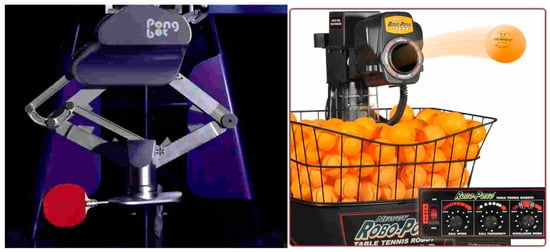
Figure 1.
Smart table tennis sports equipment.
3.2. Current Situation of Psychological Training of Table Tennis Players
Psychological stress can cause a series of problems in human beings, such as depression, weight gain, tension, anxiety, trouble with sleep and eating, mental distress, and many other obstacles, thus affecting work, study, and life. In severe cases, it will lead to adverse tendencies such as personality change and suicide [20]. The formation of psychological stress generally includes three stages: the first stage, stressor; the second stage, cognitive assessment; and the third stage, anxiety response. Cognitive assessment refers to a situation that people think they are going through, which is indeed a threat to the human being itself, and which then constitutes psychological stress. But if humans perceive it as relaxation or entertainment, rather than a threat, then it does not constitute psychological stress, a process academics call cognitive assessment. Anxiety responses emphasize that humans themselves have become aware of their own physical health, personal safety, success or failure at work, and even when those they care about are in danger or at risk, what scholars call a series of psychological or physiological responses [21]. In conclusion, the formation process of psychological stress is a stressor cognitive evaluation anxiety response.
Concentration is a prerequisite for an athlete’s performance to improve, will is the quality an athlete should have, and relieving tension is an essential key for an athlete to win. A questionnaire was conducted for these three special psychological trainings, and only 7 coaches practiced the attention training, accounting for 43.75%; 11 coaches trained the athletes in the will training, accounting for 68.75%; and the training to relieve the tension of the athletes is very important, and all the coaches have trained the athletes. It can be seen from this paper that all coaches have considered alleviating the nervousness of athletes and have taken measures; however, more than half of the coaches have neglected to focus on training [22,23].
During this study, the researchers conducted a questionnaire survey on the experimental subjects, and a questionnaire test of different psychological contents, the table tennis players could choose according to their current psychological state, such as whether they would worry about the results of the competition, environmental adaptability, inferiority, and other psychological pressure states: anger, regret, and trust after the game. Through the questionnaire survey, the questionnaire data of table tennis players could be organized, counted, and analyzed, and finally, the psychological pressure state of the athletes.
Through the analysis of Table 1, Table 2 and Table 3, it can be found that there are many specific problems of table tennis players before the game, but the problems presented by this group also have commonalities. That is, table tennis players generally have a serious sense of inferiority, weak willpower, weak feelings, poor environmental adaptability, relatively poor ability, and so on. Table tennis players will experience shortness of breath, rapid heartbeat, and muscle incoordination in various parts of the body during the game which is a normal state of psychological stress that people show under special circumstances. In the tense stadium atmosphere and pre-match training, this pressure will be more intense and more obvious at the same time. Table tennis players are often criticized by coaches, parents, and players when they offer feedback after the game. In the process of criticism and accusation, table tennis players always think about continuing to strengthen their efforts in future life and training to ensure that they will win the next game. However, once the failure occurs again in a future game, the table tennis player will repeatedly experience frustration and remorse.

Table 1.
Psychological stress before the game.

Table 2.
Psychological stress during the game.

Table 3.
Post-match psychological stress.
4. Investigation on Psychological Training of Table Tennis Players
4.1. Video-Based Method for Face Heart Rate Detection
This study selects table tennis players in Hunan Province as the object of investigation and takes the emotional changes of table tennis players participating in the competition in the past year as the analysis target. Table 1 shows the situation of table tennis players in Hunan Province. In the end, this study selects a W (female, 12 years old, with 6 years of training, and is a national first-level athlete) who has high expectations of coaches but low self-relief ability as the main subject of this casework method. The author intervenes through the case method, uses the casework method to establish contact with w, and reduces the psychological pressure of small w competition through the casework skills. The author intervenes through the case method and uses the casework method to establish a connection with W. At the same time, through casework skills to relieve the psychological pressure of small w competition.
A questionnaire refers to a form used in statistics and surveys to ask questions in the form of questions. Through the design of questionnaires, relevant information is directly collected to analyze whether athletes have certain psychological problems. Since the Hunan Women’s Table Tennis Team is the selection team of the Chinese Table Tennis Team, this series of psychological problems is private in society, and the questionnaire is a method of not recording names throughout the process. In the questionnaire survey stage, the author mainly conducted the questionnaire star survey. A total of 20 questionnaires were distributed and 20 questionnaires were returned, with a recovery rate of 100% and an effective recovery rate of 100%. In the 20 questionnaires, after the author’s screening, there are 20 survey results, which were used by the author in the compilation of this paper. At the same time, due to the confidentiality of the data, the author assures the coaches and players of the Hunan Women’s Table Tennis Team that the questionnaire will not be used for purposes other than this paper.
4.2. Video-Based Face Heart Rate Detection Process
4.2.1. Video Heart Rate Detection
Based on the actual training scene of the smart table tennis in this paper, the daily environment is under the illumination of natural light or normal light. In this paper, the camera installed above the ball machine can collect continuous normal face images. Since video-based heart rate detection has high requirements for real time and stability of face image frames [24], in this paper, a relatively mature algorithm based on the ERT method of the Dlib library is selected to perform face detection feature point labeling and related tracker methods to track face feature parts. In this paper, the skin color RGB signal is extracted based on a fixed ROI (RegionOfInterest), and the average real-time heart rate is obtained by digital signal processing. As shown in Figure 2, it is a flowchart of video heart rate detection:
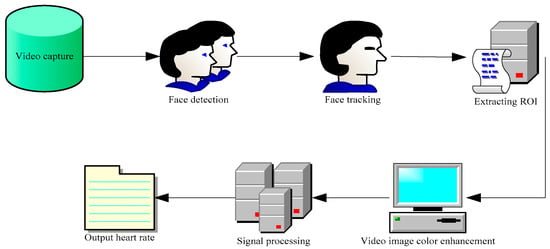
Figure 2.
Flow chart of video heart rate detection.
Landmark is a technology for extracting facial feature points. The Dlib library is marked with 68 face points. Figure 3 is a schematic diagram of the 68 marked face key points. Through the rapid real-time detection of the extracted 68 key points, a very wide range of applications can be generated, which can be used for eye fatigue detection and so on.
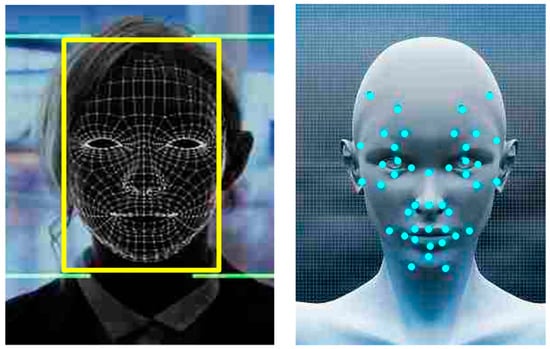
Figure 3.
Schematic diagram of face key point annotation.
The purpose of face detection is to extract the rectangular outline frame of the face from each frame of the video. The purpose of face alignment is to find several landmark parts on the face, such as the nose, eyes, etc. It is further cropped to facilitate subsequent processing. In the Dlib library, due to the high real-time requirements in the actual scene of this paper, this paper adopts the method of HoGFaceDetector [25]. The main idea of HoG is to use the local edge features of the face to represent the directional gradient histogram to detect the region of the face shape. The model consists of 5 HOG filters—front, left, right, front but rotated left, and front but rotated right [26,27].
The gradient of any pixel (x, y) in the simulated image f(x, y) is a vector, as shown in Equation (1):
Among them, is the gradient along the x direction, is the gradient along the y direction, and the magnitude and direction angle of the gradient can be expressed as shown in Equations (2) and (3):
The one-dimensional discrete differential template then calculates the gradient information of the image simply, quickly, and effectively. The formulas are shown in Equations (4) and (5):
In the formula, , , H(x, y), respectively, represent the gradient of the pixel point (x, y) in the horizontal and vertical directions and the gray value of the pixel. The formulas for calculating the magnitude and direction of its gradient are shown in Equations (6) and (7):
The advantages of using the HOG feature-based method are as follows. (1) It has the characteristics of being lightweight and is the fastest method running on the CPU. (2) It is used for frontal and slightly non-frontal faces. (3) Compared with the recognition effect of using other features, in the actual use process of this paper, considering the complexity of people in the venue, there will be cases where a small part of the face is occluded or not collected.
But the shortcomings are mainly concentrated in the following aspects. (1) The detector has a poor recognition effect when the collected video is far from the face because the model requires a minimum input size of 80 × 80 face image. (2) The blurred image opportunity caused by severe occlusion and high-speed movement cannot work. (3) It is not suitable for extreme facial postures, such as a large-angle top view. In the face alignment operation, the regression tree method learned by gradient boosting is used and optimized [28].
4.2.2. Face Tracking through Dlib
Due to the actual use environment of this paper, the training table tennis players will frequently make movements to return the ball. In order to avoid frequent loss of face detection frame affecting the accuracy of heart rate detection calculation, this paper needs to introduce a tracker to track the face area and provide a complete video sequence frame to facilitate the subsequent processing of RGB images.
At present, models in large-scale practical scenarios, or deep learning network models based on embedded onboard applications, all need to have certain lightweight requirements. An overly complex network structure will be difficult to meet the real-time and low-latency requirements due to its long training period and complex parameter adjustment operations. For example, in license plate detection and pedestrian gait detection, very high recognition speed and accuracy are required. Future research directions may focus on compressing the network structure to improve computational efficiency. In 2018, Google Research first proposed a lightweight network structure model of MobileNet [29,30]. Its performance takes into account the accuracy and real-time performance in a compromising manner, while reducing the size of the model and network parameters, simplifying the network structure, and speeding up the calculation efficiency to meet the lightweight requirements for practical use.
The correlation tracker single-target tracking algorithm in Dlib mainly uses the MobileNet-SSD detection method [31]. The specific process is shown in Figure 4:
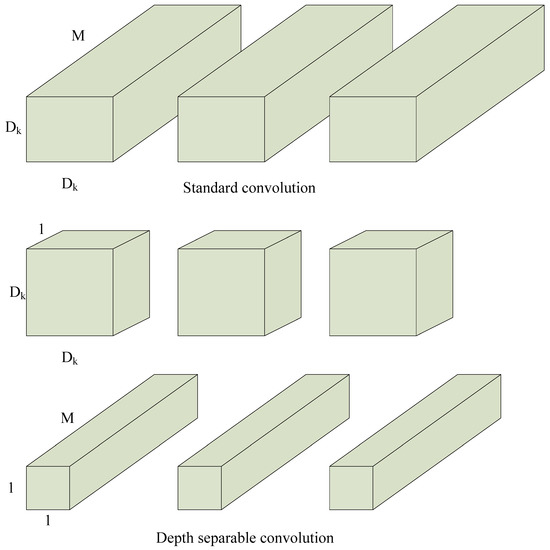
Figure 4.
Schematic diagram of separable convolution.
At the same time, two hyperparameters are introduced to reduce the number of parameters and calculations, namely the width multiplier reduces the channels of input and output, and the resolution multiplier reduces the size of the input and output feature map. Compared with standard convolution, depthwise separable convolution can reduce the amount of computation by about 9 times, while reducing a large amount of network parameter storage space.
The target area is detected by using the MobileNet-SSD method, which uses OpenCV annotation to record the detection frame of each recognition area at the same time. The method uses the rectangular area to initialize multiple trackers to be used. Multiple trackers can find and mark the target area in the next stitch, and repeat the above process to complete the process of tracking the entire target area. In order to improve computational efficiency, this paper initializes and runs these target trackers in parallel, which improves the tracking speed and enables the tracking of multi-target feature regions.
4.3. Signal Extraction and Processing
Medical research has shown that the skin tissue of the human face has a certain multi-layer structure, has a certain degree of transparency, and will have a certain response to the lighting of the light. The specific structure is shown in Figure 5.
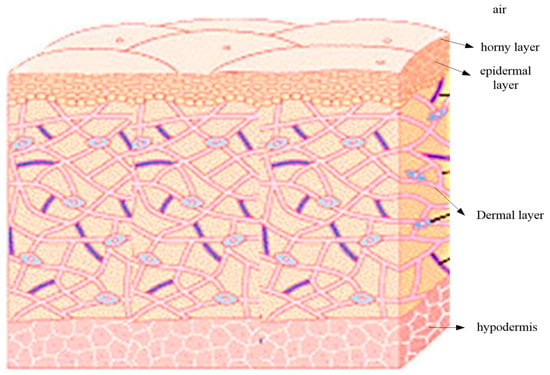
Figure 5.
Schematic diagram of human skin tissue.
When light hits the skin, different color components produce different degrees of absorption. When the light is illuminated normally, only a small part of the light below 10% will be reflected by the stratum corneum, and most of the remaining light will enter the epidermis with melanin. Part of the light will be absorbed by melanin in the epidermis, scattered in the epidermis, and the rest of the light will enter the dermis with hemoglobin. Therefore, when the light is irradiated, part of it will be absorbed by melanin, and part of it will enter the dermis. The hemoglobin in the dermis will change regularly with people’s breathing and blood circulation, so the absorption of light by hemoglobin will also change regularly, resulting in regular changes in the skin color of the human face.
Because the directly collected face video pictures may have the characteristics that the facial skin color features are not obvious enough, this paper can use the Euler video magnification algorithm to perform Euler video magnification processing on the face ROI (RegionOfInterest) obtained after face detection and face tracking and amplify the changed signal, that is, amplify the characteristics of the color component. The specific flow chart of the method of Eulerian Video Magnification is shown in Figure 6, in which triangles are different magnification factors, which are used to amplify the signal of interest.
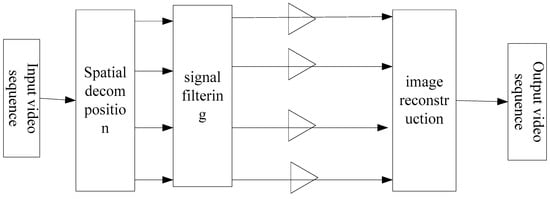
Figure 6.
Flowchart of Euler video zoom algorithm.
The first step is to perform spatial decomposition filtering. It performs pyramidal multi-resolution decomposition of video sequences, which helps reduce noise. In the spatial frequency, the lower the spatial frequency, the higher the signal-to-noise ratio of the signal; that is, the higher the proportion of information contained in the signal, and the more features it contains. In order to prevent the occurrence of signal distortion loss characteristics, different amplification factors should be used for different baseband signals to extract the signal characteristics required in this paper. The second step is time domain signal filtering. Temporal bandpass filtering is performed on the images at each scale to obtain the desired frequency bands.
Since the color signal in the RGB space is relatively weak, in order to better extract features, an ideal bandpass filter is used. As shown in Figure 7, is selected as 0.75 Hz, and is selected as 1.0 Hz. According to the actual medical measurement, the human body’s heartbeat per minute varies from 24 beats to 200 beats, and the corresponding frequency is between 0.4 Hz and 3 Hz. This paper selects the normal heartbeat interval of 60 to 120 to amplify the signal characteristics, and the corresponding frequencies are 0.8 Hz and 1.0 Hz.
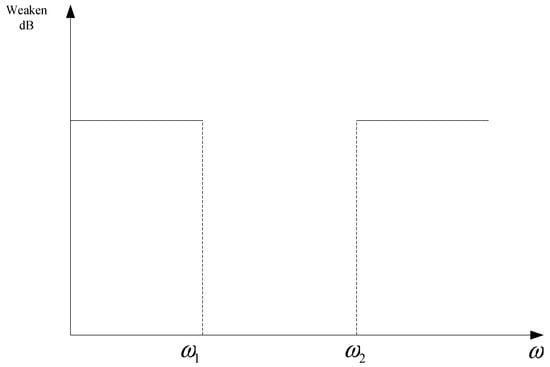
Figure 7.
Schematic diagram of ideal bandpass filter.
The third step is to amplify the filtered result. It uses to represent the intensity of the image space at x and time t, the initial moment formula is shown in Equation (8), f(x) is the image brightness:
The image pixel value will change with time, and is used to represent the displacement function, then the image intensity at time t is shown in Equation (9):
The signal of each frequency band is approximated differentially by the Taylor series, and the result of the approximation is linearly amplified. Its signal expression is shown in Equation (10):
Use a bandpass filter for to extract signals other than , that is, , which is then denoted as . Multiplying by the amplification factor and adding the original signal can be obtained as shown in Equation (11):
The output signal is obtained by expanding the Taylor first-order formula as shown in Equation (12):
Sometimes the changed signal may not be within the selected frequency range, and the signal beyond the range will be attenuated. The amplified video output sequence is shown in Equation (13):
Among them, is the amplification factor of the kth signal.
Finally, the enlarged image is synthesized. As shown in Figure 8, the image on the right further magnifies the features of melanin. Because blood passes through the blood vessels when the heart beats, the larger the amount of blood passing through the blood vessels, the more light is absorbed by the blood, and the less light is reflected from the surface of the human skin.
The facial features collected from the video will inevitably have some noise interference. This paper adopts the method of calculating the three color spaces of R, G, and B, and uses mean filtering and delinearization to process the signal. For the i-th frame, the pixel intensity expressions of the three channels are shown in Equation (14):
Among them,, is the exposure time of the camera under a certain light source intensity, is the time-variable fraction of zero means caused by blood flow, is the reflection coefficient of the skin, and is the specular reflection value.
In order to remove the influence of noise, this paper introduces wavelet transform and uses the wavelet threshold method to remove noise. The specific flow chart is shown in Figure 8:

Figure 8.
Flow chart of wavelet threshold method.
In the practical environment of this paper, the main purpose is to remove the interference of noise such as illumination and other color components. Usually, the wavelet basis of the db system or the sym system is used to transform the signal. Then, an appropriate threshold function is selected for the graph to preserve the wavelet coefficients of the image itself to the greatest extent. Then, it uses the coefficient to carry out wavelet reconstruction to obtain the signal of denoising roar, and at the same time, normalize the RGB three-channel signal. Its formula is shown in Equation (15), where is the moving average of the i-th frame:
The features of the RGB signal are effectively amplified for further calculation [25]. Then, this paper can obtain the chrominance signal through the signals of the three colors of RGB, and subtract the luminance signal from the primary color signal to obtain the chrominance signal. In this paper, two color difference signals with relatively large color difference values are selected, and represents the blue chrominance signal, and represents the red chrominance signal. The formulas are shown in Equations (16) and (17):
At the same time, a bandpass filter is added to select a suitable heart rate range between 0.75 Hz and 3 Hz. After filtering unreasonable signals, the signal with heart rate information after passing through the band-pass filter can be expressed as Equation (18):
Among them, is the standard deviation, and and are the bandpass filtering of the signals and . For the processed noise-reduced time domain signal, this paper uses Fourier transform to convert it into a frequency domain to obtain the final heart rate result. Its formula is shown in Equation (19):
4.4. Test Results
In this paper, the front-facing camera installed at the ball machine is used to collect the facial video of table tennis players, and it can form a multiplexing of the camera with the action recognition function of table tennis players. In the calm state and the post-exercise state, ten seconds of heart rate detection results were collected under daily natural light and single-light fluorescent lamps, respectively. The comparison results are shown in Figure 9 and Figure 10:
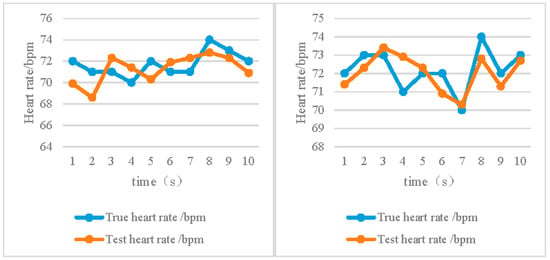
Figure 9.
Comparison of heart rate detection in calm state.
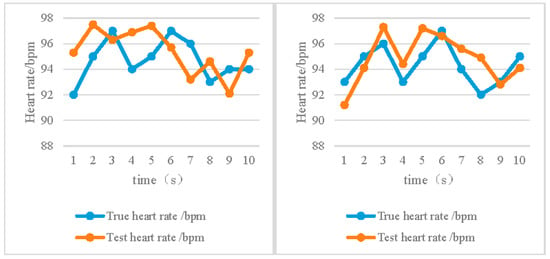
Figure 10.
Comparison of heart rate detection after exercise.
As shown in Figure 9 and Figure 10, in the video heart rate detection under the normal use of fluorescent lights, the heart rate error of the table tennis player in the calm state is between 3% compared with the result of wearing the bracelet. The difference between the video heart rate detection in the post-exercise state and the actual heart rate is within 4.3%. It showed that the detection algorithm in this paper can effectively detect the heart rate of table tennis players quickly, and has a high accuracy rate so that the heart rate of table tennis players can be reflected from the heart rate.
5. Discussion
In the experiment, a questionnaire survey about the psychological state of table tennis players, table tennis players have a serious state of inferiority, weak willpower, weak feeling, poor environmental adaptability, and relatively poor ability, including shortness of breath, rapid heartbeat, and disharmony of muscles and muscles. It can be seen that there are certain psychological problems in table tennis players before, during, and after the competition, and it is necessary to conduct psychological training for table tennis players to better improve the psychological quality of table tennis players. It can also be said that the research of the article has high practical and social value, and has great research value. At the same time, the article through the experiment of W athletes, case analysis throughout the full text, using the psychological training method for W athletes, the final results show in the normal use of fluorescent video heart rate detection, table tennis players in a calm state of heart rate error and wear a bracelet after the heart rate error between 3%. The difference between the video heart rate detection in the post-exercise state and the actual heart rate was within 4.3%. Data can show that the research hypothesis of this paper is valid. The psychological training method of face recognition based on deep learning can effectively detect the heart rate state of table tennis players, with high accuracy, so as to reflect the heart rate of table tennis players from the heart rate. Combined with the current psychological state of table tennis players, face recognition under deep learning can effectively help improve the psychological state of athletes. At the same time, the heart rate detection method of face recognition based on deep learning can not only be applied to table tennis players, but also to other sports to help assess the psychological state of athletes, so as to facilitate timely adjustment and control. The research in this article from the practice way and other scholars have certain differences. In this study, we suggest that in the case of face detection of W players, using the experimental objective validation experimental hypothesis in the final experiment, the results proved the establishment of the hypothesis, enough to prove that face recognition of heart rate detection can provide psychological training for table tennis players. However, this paper still has some flaws, such as not analyzing the table tennis teams in many places using the questionnaire, which will be further studied in the follow-up research.
6. Conclusions
This article first adopted the method of a survey questionnaire of table tennis players in order to investigate the psychological problems that players experience. The survey found: table tennis players generally have a serious sense of inferiority, weak willpower, feel weak, have poor environmental adaptability, and generally their abilities are relatively poor, particularly for table tennis players after exercise in a state of shortness of breath, fast heartbeat, and all parts of the body muscles are in disharmony. The main content of the study is the main method of non-contact video heart rate detection. Through real-time and stable face detection and tracking in the database library, the Euler video amplification algorithm is used to amplify the RGB signal in the characteristic area, carry out wavelet reconstruction to remove the environmental noise, and, finally, obtain the specific real-time heart rate and let the table tennis players under different sports states of light and experiment. The experimental results showed that in the normal use of fluorescent lamp video heart rate detection, the heart rate error of table tennis players in a calm state and the heart rate error after wearing the bracelet is between 3%. The difference between the video heart rate detection in the actual heart rate and the actual heart rate is within 4.3%. The experiment also proves that the error range of the non-contact video heart rate detection method is small, which can provide users with real-time heart rate reference. At present, table tennis players have certain problems, including that the psychological training methods need to improve, and thus the contact video heart rate detection method is particularly necessary to help table tennis players before the game, during the game, and afterward for heart rate monitoring, to control the different links between table tennis players and their heart rate status, facilitate a real-time adjustment training method, and help improve the psychological quality of table tennis players. It can be seen that the research presented in this article has great practical value and can provide certain reference significance for the psychological training of table tennis players.
Author Contributions
J.P. conceived and designed the experiments. J.P. performed the experiments and analyzed the data. B.-M.K. contributed analysis tools. B.-M.K. and J.P. wrote the paper. All authors have read and agreed to the published version of the manuscript.
Funding
This research received no external funding.
Informed Consent Statement
Informed consent was obtained from all subjects involved in the study.
Data Availability Statement
Due to the privacy of individuals that participated in the study, the data underlying this article cannot be shared publicly. The data will be shared on reasonable request with the corresponding author.
Acknowledgments
The authors wish to thank the anonymous reviewers for their valuable suggestions.
Conflicts of Interest
The authors declare no conflict of interest.
References
- Uzunov, M.; Otcheva, G. Relationship of the psychological factors in the performance of technical elements by students from Technical University of Sofia practicing table tennis in classes of physical education. SocioBrains 2018, 51, 366–375. [Google Scholar]
- Adeyeye, M.; Edward, H.; Kehinde, A.; Afolabi, F. Effects of mental-skills training on the performance of table tennis players of national institute for sport, Lagos. IOSR J. Res. Method Educ. 2013, 2, 22–27. [Google Scholar]
- Qadir, M.N.B. The effect of the mental training program on some functional variables and the level of serving accuracy in table tennis. J. Stud. Res. Sport Educ. 2021, 66, 291–310. [Google Scholar]
- Sève, C.; Leblanc, S.; Durand, M.; Sauryet, J. Course-of-action theory in table tennis: A qualitative analysis of the knowledge used by three elite players during matches. Rev. Eur. De Psychol. Appl. 2017, 55, 145–155. [Google Scholar] [CrossRef]
- CaDieux, E.G.; Gemme, C.; Dupuis, G. Effects of Yoga Interventions on Psychological Health and Performance of Competitive Athletes: A Systematic Review. J. Sci. Sport Exerc. 2021, 3, 158–166. [Google Scholar] [CrossRef]
- Feddersen, N.B.; Keis, M.; Elbe, A.M. Coaches’ perceived pitfalls in delivering psychological skills training to high-level youth athletes in fencing and football. Int. J. Sport. Sci. Coach. 2021, 16, 249–261. [Google Scholar] [CrossRef]
- An, A.; Af, A.; Tm, B.; Mp, C.; Mka, D. Psychological tools used for monitoring training responses of athletes. Perform. Enhanc. Health 2017, 5, 125–133. [Google Scholar]
- Iryna, R. Psychological training support for taekwondo athletes in four--year olympic cycles. Sport Sci. Hum. Health 2020, 4, 114–129. [Google Scholar] [CrossRef]
- LeCun, Y.; Bengio, Y.; Hinton, G. Deep learning. Nature 2015, 521, 436–444. [Google Scholar] [CrossRef]
- Gong, L. A Continuous Deep Learning System Study of Tennis Player Health Information and Professional Input. Comput. Intell. Neurosci. 2022, 2022, 8599894. [Google Scholar] [CrossRef]
- Yang, M.; Wei, X.; Wan, Q.; Sun, S. Live body detection during face recognition based on heart rate information. Inf. Commun. 2017, 12, 83–84. [Google Scholar]
- Zong, X.; Lipowski, M.; Liu, T.; Qiao, M.; Bo, Q. The Sustainable Development of Psychological Education in Students’Learning Concept in Physical Education Based on Machine Learning and the Internet of Things. Sustainability 2022, 14, 15947. [Google Scholar] [CrossRef]
- Wu, Y.; Ji, L.; Shu, X.; Ji, C.; Zhao, K.; Wang, J.; Hui, Z. iTTVis: Interactive Visualization of Table Tennis Data. IEEE Trans. Vis. Comput. Graph. 2017, 24, 709–718. [Google Scholar] [CrossRef]
- Zhou, X.; Kang, Y.; Zhang, Y.; Xiao, D. Research on the phenomenon of “crash” in table tennis competition based on the perspective of heart rate characteristics. In Proceedings of the Chinese Sports Science Society. Summary of the 12th National Sports Science Conference—Special Report (Sports Training Branch), Rizhao, China, 25 March 2022; pp. 53–55. [Google Scholar]
- Chen, B. Analysis of the Psychological Characteristics of Top Female Table Tennis Players Based on Heart Rate Change; Shanghai Institute of Physical Education: Shanghai, China, 2017. [Google Scholar]
- Wei, Q.; Zhang, J. A multidimensional empirical study of exercise anxiety in table tennis players in different competition situations. Zhejiang Sport. Sci. 2010, 32, 13–16. [Google Scholar]
- Veskovic, A.; Koropanovski, N.; Dopsaj, M.M.; Jovanovic, S. Effects of a Psychological Skill Training Program on Anxiety Levels in Top Karate Athletes. Rev. Bras. Med. Esporte 2019, 25, 418–422. [Google Scholar] [CrossRef]
- Nagovitsyn, R.S.; Miroshnichenko, A.A.; Merzlyakova, D.R.; Faizullina, G.Z. Interrelation of mental “burn out” level and psychological health in athletes with different qualification. Phys. Educ. Stud. 2018, 22, 327–331. [Google Scholar] [CrossRef]
- David, J.L.; Powless, M.D.; Hyman, J.E.; Purnell, D.M.; Fisher, S. College Student Athletes and Social Media: The Psychological Impacts of Twitter Use. Int. J. Sport Commun. 2018, 11, 163–186. [Google Scholar] [CrossRef]
- Savchuk, O.; Popovych, I. Self-efficacy of future athletes with different levels of psychological safety. J. Phys. Educ. Sport 2020, 20, 2718–2724. [Google Scholar]
- Li, D.; Gao, L. Study on heart rate load during training and simulated competition of table tennis players. Sport. World 2013, 12, 86–87. [Google Scholar] [CrossRef]
- Mizner, R.L.; Elias, A.R. Jump Training Improves Psychological Impairments and Facilitates Greater Sports Participation in Athletes with ACL Reconstruction: 2436 Board #272 June 1 9. Med. Sci. Sport. Exerc. 2018, 50, 605–606. [Google Scholar]
- Vysochina, N.; Vorobiova, A. The system of psychological correction of athlete’s personality in Olympic sport. Sport. Moksl./Sport Sci. 2017, 4, 35–45. [Google Scholar] [CrossRef]
- Ye, L.; Di, P. Optimizing the regulation and control of sports ingury and fatigue of winter olympic ice and snow athletes based on injury prevention. Rev. Bras. Med. Esporte 2021, 27, 79–82. [Google Scholar] [CrossRef]
- Madigan, D.J.; Stoeber, J.; Passfield, L. Perfectionism and training distress in junior athletes: A longitudinal investigation. J. Sport. Sci. 2017, 35, 470–475. [Google Scholar] [CrossRef]
- Glass, C.R.; Kaufman, K.A.; Pineau, T.R. Mindful Sport Performance Enhancement: Mental Training for Athletes and Coaches; American Psychological Association: Washington, DC, USA, 2018. [Google Scholar]
- Liang, L.; Beina, H. Simulation of rainfall process in mountainous regions and sports athletes’ fatigue recovery based on convolutional neural network. Arab. J. Geosci. 2021, 14, 1–15. [Google Scholar] [CrossRef]
- Stenzel, L.; Rcken, M.; Borgmann, S. Developing and Implementing an App-Based Blended Psychological Skills Training: A Case Study. Sport Psychol. 2021, 35, 155–167. [Google Scholar] [CrossRef]
- Mcguigan, H.E.; Hassmén, P.; Rosic, N. Monitoring of training in high-performance athletes: What do practitioners do? J. Sci. Sport Exerc. 2021, 5, 121–129. [Google Scholar]
- Bebetsos, E.; Aggelakis, E.; Bebetsos, G.; Gargalianos, D. Motivation Psychological Characteristics of Canoe-Kayak Sprint Elite Youth Athletes. Phys. Cult. Sport. Stud. Res. 2020, 85, 22–29. [Google Scholar] [CrossRef]
- Kroshus, E. Stigma, Coping Skills, and Psychological Help Seeking Among Collegiate Athletes. Athl. Train. Sport. Health Care 2017, 9, 254–262. [Google Scholar] [CrossRef]
Disclaimer/Publisher’s Note: The statements, opinions and data contained in all publications are solely those of the individual author(s) and contributor(s) and not of MDPI and/or the editor(s). MDPI and/or the editor(s) disclaim responsibility for any injury to people or property resulting from any ideas, methods, instructions or products referred to in the content. |
© 2023 by the authors. Licensee MDPI, Basel, Switzerland. This article is an open access article distributed under the terms and conditions of the Creative Commons Attribution (CC BY) license (https://creativecommons.org/licenses/by/4.0/).